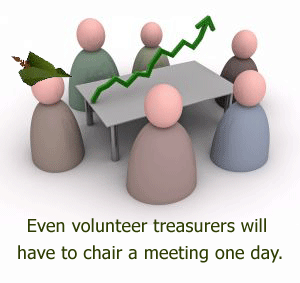 Stop right there. Don’t think you can slip away like Robin Hood disappearing into the forest. This concerns you.
Stop right there. Don’t think you can slip away like Robin Hood disappearing into the forest. This concerns you.
It is inevitable that, as volunteer treasure, you will be chairing a meeting at some stage. If yours is a large not for profit you might find yourself chairing the Finance Subcommittee meetings. If yours is a small organisation, it’s quite possible that you will need to fill in for an absent chairperson. That’s why it is important that you understand what is involved.
The role of the Chair is to manage the conduct of the meeting so it runs smoothly, addresses the issues on the Agenda and ensures that relevant decisions are made. The Chair also is responsible for guiding the meeting and steering it in the right direction. This can be a challenge especially when there are critical decisions to be made, differences of opinion to be resolved or simply trying to keep the board members on track.
These tips will help you to cope when Chairing the meeting.
- 1. Ensure the Agenda is clear and concise and that all relevant papers, reports and other information have been supplied to the board members well before the meeting.
- 2. At the start of the meeting outline the main objectives of the meeting and the decisions that need to be made.
- 3. At the start of the meeting, review and prioritise the Agenda and ensure that any critical issues are given priority.
- 4. Be clear about whether the Agenda item requires an actual decision to be made, to be discussed or simply to be noted.
- 5. Try to keep the meeting on time and if you have allocated time against each Agenda item then stick to it. If you find that there is a need to devote more time to a particular item then discuss with the board whether to continue the discussion, defer until the next meeting or to defer other less important Agenda items.
- 6. If you believe the meeting will go over time then discuss with the other board members and get agreement to continue past the time or decide which agenda items can be deferred. There is nothing worse than spending considerable time discussing an issue then as you are getting close to making a formal resolution some board members need to leave due to other commitments.
- 7. Ensure that any discussion is relevant to the agenda item and does not get side tracked on other issues.
- 8. Ensure everyone has had a chance to raise and discuss their views and that no one particular board member dominates the discussion.
One final point that is probably the most important is for the Chair to bring the discussion to an end once they believe the issue has been adequately discussed. The Chair may then provide a summary of the discussion and then propose a motion. This motion may be either a recommendation contained in a prepared report or it may be suggested by the Chair or another board member to be discussed and approved as a resolution.
If the board is divided and genuinely unable to make a decision, there are two alternatives. If the issue under discussion may be ongoing issue you might create a sub committee to deal with it. Alternatively, establish a working party if it is a short term issue. The working party can meet prior to the next meeting to discuss the relevant issues and prepare a report with recommendations.
In extreme circumstances when the board is still unable to make a decision, an extraordinary general meeting can be called. The constitution should detail the circumstance for this type of meeting and in some cases also specifies whether members, other than board members, can vote on the issue.
In the next post we will look more closely at how to prepare for a meeting and how to make the minutes of meeting work for you.

 Posted on 1,Oct |
Posted on 1,Oct |
 Posted by Anne
Posted by Anne 




There are no comments yet